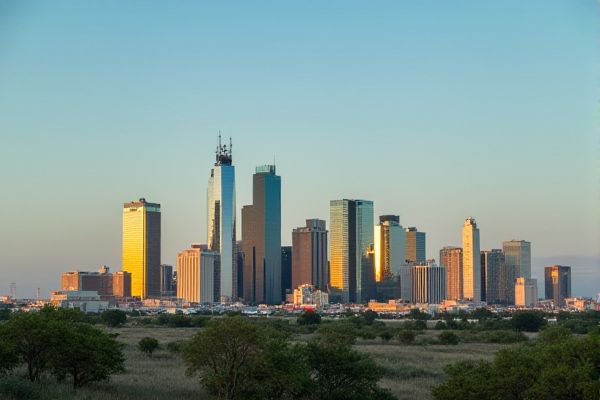
Transportation and commuting in Texas: Extensive road network and highways. Public transit options vary by city. Texas high-speed rail in development. Car dependency is prevalent. Major airports in key cities. Traffic congestion in urban areas. Toll roads in some regions. Bike and pedestrian paths limited. Ride-sharing services widely available. Regional commuter trains in select areas.
Extensive road network and highways.
Texas boasts an extensive road network that includes the largest state highway system in the United States, featuring Interstate Highways, U.S. Highways, state highways, loops, spurs, beltways, and farm-to-market roads. All these roads are maintained by the Texas Department of Transportation (TxDOT). This comprehensive system spans over 66,000 miles of highways, incorporating substantial stretches of Interstate Highways, and seamlessly connects both rural and urban areas across the vast state.
Public transit options vary by city.
Public transit options in Texas vary significantly by city, with urban areas like Houston, Dallas, and San Antonio offering comprehensive networks including buses, light rail, and commuter rail. In contrast, smaller cities and rural areas rely on more limited services such as fixed-route buses and dial-a-ride systems. For more information on the specifics of these transit options, you can explore the Texas Transit Agencies website, which provides detailed insights into the available transportation services across different regions in Texas.
Texas high-speed rail in development.
The Texas High-Speed Rail project, led by Texas Central Partners, aims to connect Dallas and Houston with a 240-mile route, allowing travel at speeds of 186-205 mph and a journey time of less than 90 minutes. The project involves partnerships with various companies, including Renfe Operadora for operations and Webuild for construction, and has received significant regulatory approvals and funding support despite past setbacks. For more details on the progress and vision of this transformative transport initiative, visit the official Texas Central website.
Car dependency is prevalent.
In Texas, particularly in the Dallas-Fort Worth area, car dependency is highly prevalent, with only a small percentage of households in Dallas County having no car, and nearly 74% having one or two cars. This dependency is driven by the region's spread-out development, making cars a necessity for daily activities, and is associated with high costs, road congestion, and negative social and environmental impacts. For more detailed insights on this issue, you can explore the discussion on car dependency in Dallas at Axios, where the breadth of this topic is explored in greater depth.
Major airports in key cities.
Texas is served by several major airports in key cities, including Dallas-Fort Worth International Airport (DFW), George Bush Intercontinental Airport (IAH) in Houston, Dallas Love Field (DAL), William P. Hobby Airport (HOU) in Houston, Austin-Bergstrom International Airport (AUS), and San Antonio International Airport (SAT), which are significant hubs for both domestic and international flights. For more detailed information, you can visit the Maps of the World website.
Traffic congestion in urban areas.
Traffic congestion in Texas' urban areas is severe, with Houston, Dallas, Austin, and San Antonio ranking among the most congested cities in the U.S., causing significant time and economic losses for commuters. Drivers in these cities lose up to 62 hours per year to gridlock, highlighting the urgent need for effective transportation solutions to alleviate the burden on Texas residents.
Toll roads in some regions.
Toll roads in Texas are extensively mapped and organized by region, including Dallas-Fort Worth, Houston-Galveston, Austin-Round Rock, and other areas. Each region has individual toll road maps, listing nearby services such as gas stations, EV charging, fast food, and hotels, and categorizing roads as state, local, or toll bridges/tunnels. For comprehensive details, explore the Texas Toll Road Maps which provide a clear overview of the road infrastructure and available amenities in these key urban centers.
Bike and pedestrian paths limited.
In Texas, state laws permit bicyclists to share roadways and generally do not restrict bicycles on sidewalks unless local ordinances dictate otherwise. Pedestrians, on the other hand, are required to utilize sidewalks if they are available. The availability and quality of bike and pedestrian paths can vary significantly, and some regions are notably deficient in adequate facilities. This issue is particularly prevalent in cities like Houston, where recent policy changes have stopped or reversed projects aimed at improving bike and pedestrian infrastructure. For more detailed information on this topic, you can explore the Texas Department of Transportation's Bicycle and Pedestrian Safety Guidelines, which provide a comprehensive overview of the current laws and regulations.
Ride-sharing services widely available.
Ride-sharing services such as Uber, Lyft, and others like Blacklane and Arro are widely available in major Texas cities, including Houston and Dallas, offering various service levels and capacities to cater to different needs and preferences. These services ensure convenient and flexible transportation options for both residents and visitors, making urban travel more accessible and efficient.
Regional commuter trains in select areas.
The Trinity Railway Express (TRE) serves as a vital commuter rail service in the Dallas-Fort Worth metroplex, seamlessly connecting Dallas and Fort Worth while passing through various intermediate cities. Jointly operated by Dallas Area Rapid Transit (DART) and Trinity Metro, the TRE runs six days a week, offering peak hour frequencies and facilitating convenient links to other transit services such as the DART Green Line and TEXRail. Meanwhile, TEXRail covers a 27-mile stretch from downtown Fort Worth to the northern entrance of Dallas/Fort Worth International Airport, with frequent stops in North Fort Worth, North Richland Hills, and Grapevine. Committed to daily operations, TEXRail remains active throughout the year, providing half-hourly trains during peak periods and hourly services during non-peak times. The A-train, operated by the Denton County Transportation Authority (DCTA), further enhances the region's transit network by linking Denton to the DART Green Line at Trinity Mills Station in Carrollton. Operating Monday through Saturday, except on major holidays, the A-train ensures easy access to various destinations within Denton County while facilitating connections to Dallas County.
